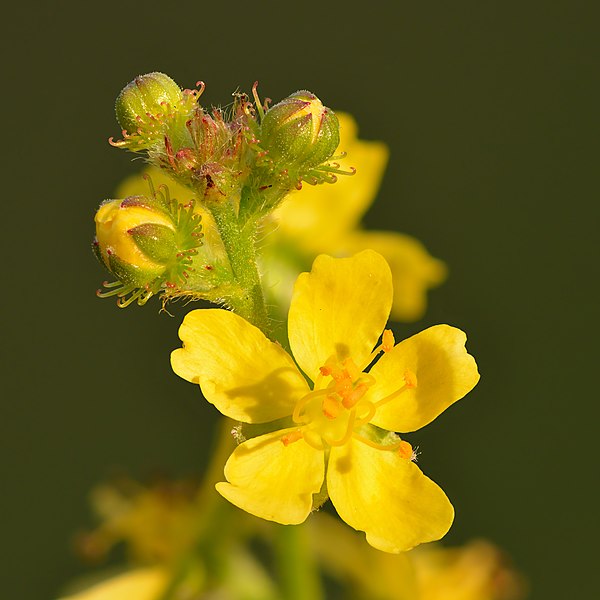 Agrimony
Agrimony
Common name
Agrimony
ID
HD0067
Scientific name of the plant
Agrimonia eupatoria L.
Anatomical part for use
N/A
Human use
Mouth and throat disorders,Skin disorders & minor wounds,Gastrointestinal disorders
Summary
Agrimonia (from the Greek ἀργεμώνη), commonly known as agrimony, is a genus of 12–15 species of perennial herbaceous flowering plants in the family Rosaceae, native to the temperate regions of the Northern Hemisphere, with one species also in Africa. The species grow to between .5–2 m (1.6–6.6 ft) tall, with interrupted pinnate leaves, and tiny yellow flowers borne on a single (usually unbranched) spike.
Agrimonia species are used as food plants by the larvae of some Lepidoptera species including grizzled skipper (recorded on A. eupatoria) and large grizzled skipper.
Evidence Level
Level 0 (No convinced report of liver injury caused by herbal and dietary supplement)
Hepatotoxicity Description
N/A
Uses
In ancient times, it was used for foot baths and tired feet. Agrimony has a long history of medicinal use. The English poet Michael Drayton once hailed it as an "all-heal" and through the ages it was considered a panacea. The ancient Greeks used agrimony to treat eye ailments, and it was made into brews for diarrhea and disorders of the gallbladder, liver, and kidneys. The Anglo-Saxons boiled agrimony in milk and used it to improve erectile performance.
They also made a solution from the leaves and seeds for healing wounds; this use continued through the Middle Ages and afterward, in a preparation called eau d'arquebusade, or "musket-shot water". It has been added to tea as a spring tonic. (Source: Wiki)

Common name
Agrimony
ID
HD0067
Scientific name of the plant
Agrimonia eupatoria L.
Anatomical part for use
N/A
Human use
Mouth and throat disorders,Skin disorders & minor wounds,Gastrointestinal disorders
Summary
Agrimonia (from the Greek ἀργεμώνη), commonly known as agrimony, is a genus of 12–15 species of perennial herbaceous flowering plants in the family Rosaceae, native to the temperate regions of the Northern Hemisphere, with one species also in Africa. The species grow to between .5–2 m (1.6–6.6 ft) tall, with interrupted pinnate leaves, and tiny yellow flowers borne on a single (usually unbranched) spike. Agrimonia species are used as food plants by the larvae of some Lepidoptera species including grizzled skipper (recorded on A. eupatoria) and large grizzled skipper.
Evidence Level
Level 0 (No convinced report of liver injury caused by herbal and dietary supplement)
Hepatotoxicity Description
N/A
Uses
In ancient times, it was used for foot baths and tired feet. Agrimony has a long history of medicinal use. The English poet Michael Drayton once hailed it as an "all-heal" and through the ages it was considered a panacea. The ancient Greeks used agrimony to treat eye ailments, and it was made into brews for diarrhea and disorders of the gallbladder, liver, and kidneys. The Anglo-Saxons boiled agrimony in milk and used it to improve erectile performance. They also made a solution from the leaves and seeds for healing wounds; this use continued through the Middle Ages and afterward, in a preparation called eau d'arquebusade, or "musket-shot water". It has been added to tea as a spring tonic. (Source: Wiki)